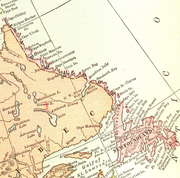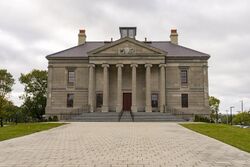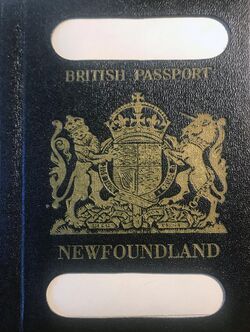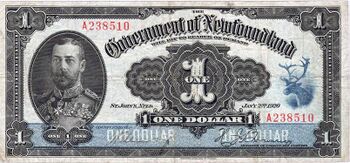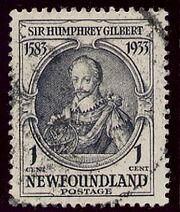Finance:Dominion of Newfoundland
Newfoundland | |||||||||||
|---|---|---|---|---|---|---|---|---|---|---|---|
| 1907–1949 | |||||||||||
Motto: Quaerite prime regnum Dei (Latin) "Seek ye first the kingdom of God" | |||||||||||
Anthem: "Ode to Newfoundland" File:Odetonewfoundland.ogg | |||||||||||
 Map of the Dominion of Newfoundland | |||||||||||
| Status |
| ||||||||||
| Capital and largest city | St. John's | ||||||||||
| Government | Responsible government | ||||||||||
| King | |||||||||||
• 1907–1910 (first) | Edward VII | ||||||||||
• 1936–1949 (last) | George VI | ||||||||||
| Governor | |||||||||||
• 1907–1909 (first) | Sir William MacGregor | ||||||||||
• 1946–1949 (last) | Sir Gordon Macdonald | ||||||||||
| Prime Minister | |||||||||||
• 1907–1910 (first) | Sir Robert Bond | ||||||||||
• 1932–1934 (last) | Frederick C. Alderdice | ||||||||||
| Legislature | House of Assembly | ||||||||||
| History | |||||||||||
• Semi-sovereign dominion | 26 September 1907 | ||||||||||
• Fully sovereign dominion | 19 November 1926 | ||||||||||
• Statute of Westminster | 11 December 1931 | ||||||||||
• British dominion-dependency | 16 February 1934 | ||||||||||
• Province of Canada | 31 March 1949 | ||||||||||
| Currency | Newfoundland dollar | ||||||||||
| |||||||||||
| Today part of |
| ||||||||||
*National holidays celebrated on 24 June, Discovery Day, and 26 September, Dominion Day. Patron saint John the Baptist. | |||||||||||
Newfoundland was a British dominion in eastern North America, today the modern Canadian province of Newfoundland and Labrador. It was confirmed by the Balfour Declaration of 1926 and the Statute of Westminster of 1931. It included the island of Newfoundland, and Labrador on the continental mainland. Newfoundland was one of the original dominions within the meaning of the Balfour Declaration, and accordingly enjoyed a constitutional status equivalent to the other dominions of the time.
In 1934, Newfoundland became the only dominion to give up its self-governing status, which ended 79 years of self-government.[1] The abolition of self-government came about because of a crisis in Newfoundland's public finances in 1932. Newfoundland had accumulated a significant amount of debt by building a railway across the island, which was completed in the 1890s, and by raising its own regiment during the First World War.[1] In November 1932, the government warned that Newfoundland would default on payments on the public debt.[1] The British government quickly established the Newfoundland Royal Commission to inquire into and report on the position.[1] The commission's report, published in October 1933, recommended that Newfoundland give up self-government temporarily and allow the United Kingdom to administer it by an appointed commission.[1]
The Newfoundland parliament accepted the recommendations and presented a petition to the King to ask for the suspension of the constitution and the appointment of commissioners to administer the government until the country became self-supporting again.[2] To enable compliance with the request, the British Parliament passed the Newfoundland Act 1933, and on 16 February 1934, the British government appointed six commissioners, three from Newfoundland and three from the United Kingdom, with the governor as chairman.[2] The system of a six-member Commission of Government continued to govern Newfoundland until Newfoundland joined Canada in 1949 to become Canada's tenth province.[3]
Etymology and national symbols
The official name of the dominion was "Newfoundland" and not, as was sometimes reported, "Dominion of Newfoundland". The distinction is apparent in many statutes, most notably the Statute of Westminster that listed the full name of each realm, including the "Dominion of New Zealand", the "Dominion of Canada", and "Newfoundland".[4]
The Newfoundland Blue Ensign was used as the colonial flag from 1870 to 1904. The Newfoundland Red Ensign was used as the de facto national flag of the dominion[5] until the legislature adopted the Union Flag on 15 May 1931.
The anthem of the dominion was the "Ode to Newfoundland", written by British colonial governor Sir Cavendish Boyle in 1902 during his administration of Newfoundland (1901 to 1904).[6] It was adopted as the dominion's anthem on 20 May 1904, until confederation with Canada in 1949. In 1980, the province of Newfoundland re-adopted the song as a provincial anthem. The "Ode to Newfoundland" continues to be heard at public events in the province; however, only the first and last verses are traditionally sung.
Political origins
The remaining North American colonies (the Province of Canada - previously Upper Canada and Lower Canada; Colony of Newfoundland; Nova Scotia; New Brunswick; Prince Edward Island; Rupert's Land; British Arctic Territories; Columbia District/Oregon Country - shared with the United States; and Bermuda), after the 1783 independence of the thirteen that became the United States of America , were administered collectively within the British Empire as British North America.
From 1824, the British Empire was divided by the War and Colonial Office into four administrative departments, including NORTH AMERICA, which was made up of:[7]
- Upper Canada, Lower Canada
- New Brunswick, Nova Scotia, Prince Edward Island
- Bermuda, Newfoundland
In 1854, the British government established Newfoundland's responsible government.[8] In 1855, Philip Francis Little, a native of Prince Edward Island, won a parliamentary majority over Sir Hugh Hoyles and the Conservatives. Little formed the first administration from 1855 to 1858.
Under the 1867 Confederation of Canada, all except Newfoundland and Bermuda confederated to form the Dominion of Canada. Newfoundland rejected confederation with Canada in the 1869 general election. Sir John Thompson, Prime Minister of Canada, came very close to negotiating Newfoundland's entry into Confederation in 1892.
It remained a colony until the 1907 Imperial Conference resolved to confer dominion status on all self-governing colonies in attendance.[9] The annual holiday of Dominion Day was celebrated each 26 September to commemorate the occasion.
First World War and afterwards
Newfoundland's own regiment, the 1st Newfoundland Regiment, fought in the First World War. On 1 July 1916, the German Army wiped out most of that regiment at Beaumont Hamel on the first day on the Somme, inflicting 90 percent casualties.[10][page needed] Yet the regiment went on to serve with distinction in several subsequent battles, earning the prefix "Royal". Despite people's pride in the accomplishments of the regiment, Newfoundland's war debt and pension responsibility for the regiment and the cost of maintaining a trans-island railway led to increased and ultimately unsustainable government debt in the post-war era.[11]
After the war, Newfoundland along with the other dominions sent a separate delegation to the Paris Peace Conference but, unlike the other dominions, Newfoundland neither signed the Treaty of Versailles in her own right nor sought separate membership in the League of Nations.
In the 1920s, political scandals wracked the dominion. In 1923, the attorney general arrested Newfoundland's prime minister, Sir Richard Squires, on charges of corruption. Despite his release soon after on bail, a commission of enquiry, headed by Thomas Hollis-Walker, reviewed the scandal. Soon after, the Squires government fell. Squires returned to power in 1928 because of the unpopularity of his successors, the pro-business Walter Stanley Monroe and (briefly) Frederick C. Alderdice (Monroe's cousin), but found himself governing a country suffering from the Great Depression.
The Judicial Committee of the Privy Council resolved Newfoundland's long-standing Labrador boundary dispute with Canada to the satisfaction of Newfoundland and against Canada (and, in particular, contrary to the wishes of Quebec, the province that bordered Labrador) with a ruling on 1 April 1927. Prior to 1867, the Quebec North Shore portion of the "Labrador coast" had shuttled back and forth between the colonies of Lower Canada and Newfoundland. Maps up to 1927 showed the coastal region as part of Newfoundland, with an undefined boundary. The Privy Council ruling established a boundary along the drainage divide separating waters that flowed through the territory to the Labrador coast, although following two straight lines from the Romaine River along the 52nd parallel, then south near 57 degrees west longitude to the Gulf of Saint Lawrence. Quebec has long rejected the outcome, and Quebec's provincially issued maps do not mark the boundary in the same way as boundaries with Ontario and New Brunswick.
Newfoundland only gradually implemented its status as a self-governing dominion. In 1921, it officially established the position of High Commissioner to the United Kingdom (for which Sir Edgar Rennie Bowring had already assumed the role in 1918),[12] and it adopted a national flag and established an external affairs department in 1931,[13][14] after it had given its assent for the passage of the Statute of Westminster 1931.[15]
End of responsible government
As a small country which relied primarily upon the export of fish, paper, and minerals, Newfoundland was hit hard by the Great Depression. Economic frustration combined with anger over government corruption led to a general dissatisfaction with democratic government. On 5 April 1932, a crowd of 10,000 people marched on the Colonial Building (seat of the House of Assembly) and forced Prime Minister Squires to flee. Squires lost an election held later in 1932. The next government, led once more by Alderdice, called upon the British government to take direct control until Newfoundland could become self-sustaining. The United Kingdom, concerned over Newfoundland's likelihood of defaulting on its war-debt payments, established the Newfoundland Royal Commission, headed by a Scottish peer, The 1st Baron Amulree. Its report, released in 1933, assessed Newfoundland's political culture as intrinsically corrupt and its economic prospects as bleak, and advocated the abolition of responsible government and its replacement by a Commission of the British Government. Acting on the report's recommendations, Alderdice's government voted itself out of existence in December 1933.[1]
In 1934, the Dominion suspended Newfoundland's self-governing status and the Commission of Government took control. Newfoundland remained a dominion in name only.[16] Newfoundland was ruled by a governor who reported to the Colonial Secretary in London. The legislature was suspended.[17]
The severe worldwide Great Depression persisted until the Second World War broke out in 1939.
Second World War
Given Newfoundland's strategic location in the Battle of the Atlantic, the Allies (especially the United States of America) built many military bases there. Large numbers of unskilled men gained the first paycheques they had seen in years by working on construction and in dockside crews. National income doubled as an economic boom took place in the Avalon Peninsula and to a lesser degree in Gander, Botwood, and Stephenville. The United States became the main supplier, and American money and influence diffused rapidly from the military, naval, and air bases. Prosperity returned to the fishing industry by 1943. Government revenues, aided by inflation and new income, quadrupled, even though Newfoundland had tax rates much lower than those in Canada, Britain, or the United States. To the astonishment of all, Newfoundland started financing loans to London. Wartime prosperity ended the long depression and reopened the question of political status.
The American Bases Act became law in Newfoundland on 11 June 1941, with American personnel creating drastic social change on the island. This included significant intermarriage between Newfoundland women and American personnel.({{{1}}}, {{{2}}})[page needed]
In October of 1943, the weather station Kurt was erected in Newfoundland, marking Nazi Germany's only armed operation on land in North America.
A new political party formed in Newfoundland to support closer ties with the US, the Economic Union Party, which Karl McNeil Earle characterizes as "a short-lived but lively movement for economic union with the United States". Advocates of union with Canada denounced the Economic Union Party as republican, disloyal and anti-British. No American initiative for union was ever created.[18][page needed]
National Convention and referendums
As soon as prosperity returned during the war, agitation began to end the commission.[19][page needed] Newfoundland, with a population of 313,000 (plus 5,200 in Labrador), seemed too small to be independent.[20][full citation needed] In 1945, London announced that a Newfoundland National Convention would be elected to advise on what constitutional choices should be voted on by referendum. Union with the United States was a possibility, but Britain rejected the option and offered instead two options: return to dominion status or continuation of the unpopular Commission.[21][page needed] Canada cooperated with Britain to ensure that the option of closer ties with America was not on the referendum.[citation needed]
In 1946, an election took place to determine the membership of the Newfoundland National Convention, charged with deciding the future of Newfoundland. The Convention voted to hold a referendum to decide between continuing the Commission of Government or restoring responsible government. Joey Smallwood was a well-known radio personality, writer, organizer, and nationalist who had long criticized British rule. He became the leader of the confederates and moved for the inclusion of a third option – that of confederation with Canada. The Convention defeated his motion, but he did not give up, instead gathering more than 5,000 petition signatures within a fortnight, which he sent to London through the governor. Britain insisted that it would not give Newfoundland any further financial assistance, but added this third option of having Newfoundland join Canada to the ballot. After much debate, the first referendum took place on 3 June 1948, to decide between continuing with the Commission of Government, reverting to dominion status, or joining Canadian Confederation.
Three parties participated in the referendum campaign: Smallwood's Confederate Association campaigned for the confederation option while in the anti-confederation campaign Peter Cashin's Responsible Government League and Chesley Crosbie's Economic Union Party (both of which called for a vote for responsible government) took part. No party advocated petitioning Britain to continue the Commission of Government. Canada had issued an invitation to join it on generous financial terms. Smallwood was the leading proponent of confederation with Canada, insisting, "Today we are more disposed to feel that our very manhood, our very creation by God, entitles us to standards of life no lower than our brothers on the mainland."[22] Due to persistence, he succeeded in having the Canada option on the referendum.[23][page needed] His main opponents were Cashin and Crosbie. Cashin, a former finance minister, led the Responsible Government League, warning against cheap Canadian imports and the high Canadian income tax. Crosbie, a leader of the fishing industry, led the Party for Economic Union with the United States, seeking responsible government first, to be followed by closer ties with the United States, which could be a major source of capital.[24][full citation needed]
The result proved inconclusive, with 44.5 percent supporting the restoration of dominion status, 41.1 percent for confederation with Canada, and 14.3 percent for continuing the Commission of Government. Due to no option getting at least 50 percent of the vote, a second referendum with the top two options from the first referendum was scheduled to be held on 22 July. The second referendum, on 22 July 1948, asked Newfoundlanders to choose between confederation and dominion status, and produced a vote of 52 to 48 percent for confederation. Newfoundland joined Canada in the final hours of 31 March 1949.
See also
- Charles Jost Burchell, Canada's High Commissioner to Newfoundland, involved in negotiating union with Canada
- General elections in Newfoundland (pre-Confederation)
- High Commissioner of Newfoundland to the United Kingdom
- List of Newfoundland cases of the Judicial Committee of the Privy Council (pre-1949)
- List of political parties in Newfoundland and Labrador
- List of prime ministers of the Dominion of Newfoundland
Political parties in the Dominion of Newfoundland
- Conservative parties in Newfoundland (pre-Confederation)
- Fisherman's Protective Union
- Liberal parties in Newfoundland (pre-Confederation)
- Newfoundland People's Party
- United Newfoundland Party
References
Footnotes
- ↑ 1.0 1.1 1.2 1.3 1.4 1.5 Hiller, J. K. (2002). "The Newfoundland Royal Commission, 1933 (The Amulree Commission)". Newfoundland and Labrador Heritage Web Site. http://www.heritage.nf.ca/law/amulree.html.
- ↑ 2.0 2.1 Roberts-Wray 1966, p. 830.
- ↑ British North America Act, 1949 (12, 13 & 14 G. 6, c. 22)
- ↑ The Statute of Westminster, 1931 22 Geo. 5, c4 (UK)
- ↑ "Historic Flags of Newfoundland (Canada)". October 2005. http://www.crwflags.com/fotw/flags/ca-nf.html.
- ↑ "The Provincial Anthem: Ode to Newfoundland". https://www.heritage.nf.ca/articles/society/provincial-anthem.php.
- ↑ Young, Douglas MacMurray (1961). The Colonial Office in The Early Nineteenth Century. London: Published for the Royal Commonwealth Society by Longmans. p. 55.
- ↑ Webb, Jeff. "Representative Government, 1832–1855". http://www.heritage.nf.ca/law/representative.html.
- ↑ Minutes of Proceedings of the Colonial Conference, 1907. Cd. 3523. London: His Majesty's Stationery Office. 1907. p. v. https://archive.org/details/minutesofproceed00colo/page/n10.
- ↑ Nicholson 2010.
- ↑ "First World War and the Economy". https://www.heritage.nf.ca/first-world-war/articles/first-world-war-economy.php.
- ↑ High Commissioner's Act, 1921, SN 1921, c. 6
- ↑ An Act to provide for a National Flag for Newfoundland, and Colours to be worn on Vessels, SN 1931, c. 3
- ↑ An Act relating to the Department of External Affairs, SN 1931, c. 14
- ↑ Address to the King, SN 1931, c. 1
- ↑ Webb, Jeff A. (January 2003). "The Commission of Government, 1934–1949". Newfoundland and Labrador Heritage Web Site (2007). http://www.heritage.nf.ca/law/commission_gov.html.
- ↑ Neary 1988, p. 25.
- ↑ Earle 1998.
- ↑ Long 1999.
- ↑ MacKay 1946.
- ↑ Hiller 1998.
- ↑ Smallwood 1973, p. 256.
- ↑ Gwyn 1972.
- ↑ Hiller & Harrington 1995.
Bibliography
- Earle, Karl McNeil (Winter 1998). "Cousins of a Kind: The Newfoundland and Labrador Relationship with the United States". American Review of Canadian Studies 28 (4): 387–411. doi:10.1080/02722019809481611. ISSN 1943-9954.
- Gwyn, Richard (1972). Smallwood: The Unlikely Revolutionary.
- Hiller, James K. (1998). Confederation: Deciding Newfoundland's Future, 1934–1949.
- Hiller, James K.; Harrington, Michael F., eds (1995). The Newfoundland National Convention, 1946–1948. Montreal: McGill-Queen's University Press.
- Long, Gene (1999). Suspended State: Newfoundland Before Canada.
- MacKay, R. A., ed (1946). Newfoundland: Economic, Diplomatic, and Strategic Studies. Toronto: Oxford University Press.
- Neary, Peter (1988). Newfoundland in the North Atlantic World, 1929–1949. Kingston, Ontario: McGill-Queen's University Press. ISBN 978-0-7735-6180-9.
- Nicholson, G. W. L. (2010). The Fighting Newfoundlander: A History of the Royal Newfoundland Regiment. Montreal: McGill-Queen's University Press. ISBN 978-0-7735-7544-8.
- Overton, James (Autumn 1984). "Coming Home: Nostalgia and Tourism in Newfoundland". Acadiensis 14 (1): 84–97. ISSN 1712-7432.
- Roberts-Wray, Kenneth (1966). Commonwealth and Colonial Law.
- Smallwood, Joey (1973). I Chose Canada: The Memoirs of the Honourable Joseph R. "Joey" Smallwood.
Further reading
- Blake, Raymond B.; Baker, Melvin (2019). Where Once They Stood: Newfoundland's Rocky Road to Canada. Regina, Saskatchewan: University of Regina Press.
- Fay, C. R. (1956). Life and Labour in Newfoundland. Toronto: University of Toronto Press.
- Keith, Arthur Berriedale (1912). Responsible Government in the Dominions. Oxford: Clarendon Press. https://archive.org/details/responsiblegover01keitiala.
- ——— (1934). "The Report of the Newfoundland Royal Commission". Journal of Comparative Legislation and International Law 16 (1): 25–39. ISSN 1479-5949.
External links
- Atlantic Crossroads, a 1945 Allied propaganda film on Newfoundland's role in the Second World War
 |





